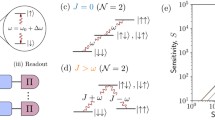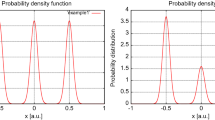Abstract
In this paper we examine Interaction-free measurement where both the probe and the object are quantum particles. We argue that in this case the description of the measurement procedure must by symmetrical with respect to interchange of the roles of probe and object. A thought experiment is being suggested that helps to determine what does and what doesn’t happen to the state of the particles in such a setup. It seems that unlike the case of classical object, here the state of both the probe and the object must change. A possible explanation of this might be that the probe and the object form an entangled pair as a result of non-interaction.





Similar content being viewed by others
References
Jacobs, K.: Quantum Measurement Theory and Its Applications. Cambridge University Press, Cambridge (2014)
Renninger, M.: Zum Wellen–Korpuskel–Dualismus. Z. Phys. 136, 251 (1953). https://doi.org/10.1007/BF01325679
Elitzur, A.C., Vaidman, L.: Quantum mechanical interaction-free measurements. Found. Phys. 23, 987 (1993). https://doi.org/10.1007/BF00736012
Kwiat, P., Weinfurter, H., Herzog, T., Zeilinger, A., Kasevich, M.: Interaction-free measurement. Phys. Rev. Lett. 74, 4763 (1995). https://doi.org/10.1103/PhysRevLett.74.4763
Kwiat, P., Weinfurter, H., Zeilinger, A.: Interaction-free measurement of a quantum object: on the breeding of “Schrodinger Cats”. In: Eberly, J.H., Mandel, L., Wolf, E. (eds.) Coherence and Quantum Optics VII, pp. 673–674. Plenum Press, New York (1996)
Hardy, L.: Quantum mechanics, local realistic theories, and Lorentz-invariant realistic theories. Phys. Rev. Lett. 68, 2981–2984 (1992). https://doi.org/10.1103/PhysRevLett.68.2981
Aharonov, Y., Botero, A., Popescu, S., Reznik, B., Tollaksen, J.: Revisiting Hardy’s paradox: counterfactual statements, real measurements, entanglement and weak values. Phys. Lett. A 301, 130–138 (2002). https://doi.org/10.1016/S0375-9601(02)00986-6
Irvine, W., Hodelin, J., Simon, C., Bouwmeester, D.: Realization of Hardy’s thought experiment with photons. Phys. Rev. Lett. 95, 030401 (2005). https://doi.org/10.1103/PhysRevLett.95.030401
Lundeen, J.S., Steinberg, A.M.: Experimental joint weak measurement on a photon pair as a probe of Hardy’s paradox. Phys. Rev. Lett. 102, 020404 (2009). https://doi.org/10.1103/PhysRevLett.102.020404
Yokota, K., Yamamoto, T., Koashi, M., Imoto, N.: Direct observation of Hardy’s paradox by joint weak measurement with an entangled photon pair. New J. Phys 11, 033011 (2009). https://doi.org/10.1088/1367-2630/11/3/033011
Azuma, H.: Interaction-free quantum computation. Phys. Rev. A 70, 012318 (2004). https://doi.org/10.1103/PhysRevA.70.012318
Huang, Y.P., Moore, M.G.: Interaction- and measurement-free quantum Zeno gates for universal computation with single-atom and single-photon qubits. Phys. Rev. A 77, 062332 (2008). https://doi.org/10.1103/PhysRevA.77.062332
Hosten, O., Rakher, M., Barreiro, J., Peters, N., Kwiat, P.: Counterfactual quantum computation through quantum interrogation. Nature 439, 949–952 (2006). https://doi.org/10.1038/nature04523
Vaidman, L.: Impossibility of the counterfactual computation for all possible outcomes. Phys. Rev. Lett. 98, 160403 (2007). https://doi.org/10.1103/PhysRevLett.98.160403
Kong, F., Ju, C., Huang, P., Wang, P., Kong, X., Shi, F., Jiang, L., Du, J.: Experimental realization of high-efficiency counterfactual computation. Phys. Rev. Lett. 115, 080501 (2015). https://doi.org/10.1103/PhysRevLett.115.080501
Salih, H., Li, Z.-H., Al-Amri, M., Zubairy, S.: Protocol for direct counterfactual quantum communication. Phys. Rev. Lett. 110, 170502 (2013). https://doi.org/10.1103/PhysRevLett.110.170502
Cao, Y., Li, Y.-H., Cao, Z., Yin, J., Chen, Y.-A., Ma, X., Peng, C.-Z., Pan, J.-W.: Lower bound on the speed of nonlocal correlations without locality and measurement choice loopholes. In: Conference on Lasers and Electro-Optics (CLEO) (2014)
Noh, T.-G.: Counterfactual quantum cryptography. Phys. Rev. Lett. 103, 230501 (2009). https://doi.org/10.1103/PhysRevLett.103.230501
Aharonov, Y., Cohen, E., Elitzur, A.C., Smolin, L.: Interaction-free effects between distant atoms. Found. Phys. 48, 1–16 (2018). https://doi.org/10.1007/s10701-017-0127-y
Potting, S., Lee, E.S., Schmitt, W., Rumyantsev, I., Mohring, B., Meystre, P.: Quantum coherence and interaction-free measurements. Phys. Rev. A 62, 060101(R) (2000). https://doi.org/10.1103/PhysRevA.62.060101
Zhou, X., Zhou, Z., Guo, G., Feldman, M.: Quantum coherence and interaction-free measurements. Phys. Rev. A 64, 020101 (2001). https://doi.org/10.1103/PhysRevA.62.060101
Angelo, R.: On the interpretative essence of the term “interaction-free measurement”: the role of entanglement. Found. Phys. 39, 109–119 (2009). https://doi.org/10.1007/s10701-008-9263-8
Scully, M.O., Englert, B.-G., Walther, H.: Quantum optical tests of complementarity. Nature 351(6322), 111–116 (1991). https://doi.org/10.1038/351111a0
Ryff, L.C., Souto Ribeiro, P.H.: Mach-Zehnder interferometer for a two-photon wave packet. Phys. Rev. A 63, 023801 (2001). https://doi.org/10.1103/PhysRevA.63.023801
Braginsky, V.B., Vorontsov, Y.I., Thorn, K.S.: Quantum nondemolition measurements. Science 209, 547 (1980). https://doi.org/10.1126/science.209.4456.547
Putz, M.V.: On Heisenberg uncertainty relationship, its extension, and the quantum issue of wave-particle duality. Int. J. Mol. Sci. 11(10), 4124–39 (2010). https://doi.org/10.3390/ijms11104124
Putz, M.V.: The Bondons: the quantum particles of the chemical bond. Int. J. Mol. Sci. 11(11), 4227–4256 (2010). https://doi.org/10.3390/ijms11114227
Vaidman, L.: The meaning of the interaction-free measurements. Found. Phys. 33, 491–510 (2003). https://doi.org/10.1023/A:1023767716236
von Neumann, J.: Mathematical Foundations of Quantum Mechanics, New, Translation ed. Princeton University Press, Princeton (2018)
Blum, K.: Density Matrix Theory and Applications. Springer, Berlin (2012)
Acknowledgements
We would like to express our gratitude to the following people and organizations who made this work possible. Rin who provided inspiration for this work. Vyacheslavs Kashcheyevs for his comments, criticism and all the help. MIT OCW, Leonard Susskind for providing knowledge. Douglas Hofstadter and Mark Strand. Carl Vandivier, TMBCC and Morgan Book for great discussions and atmosphere in Bloomington. Arnis Ritups. The support of our families has been constant and invaluable.
Author information
Authors and Affiliations
Corresponding author
Additional information
Publisher's Note
Springer Nature remains neutral with regard to jurisdictional claims in published maps and institutional affiliations.
Appendix: A Formal Proof of Aligning Bloch Spheres Representing Interacting Particles
Appendix: A Formal Proof of Aligning Bloch Spheres Representing Interacting Particles
In words this proof shows that:
given two particles with two degrees of freedom each and those DoFs being coupled to each other
for every superposition of those DoFs in one particle there is a corresponding superposition in the DoFs of the other particle that will result in an event of absorbtion in 100% of the cases.
We start with postulating what we know.
\(\exists \) an atomic state \(\left| {?}\right\rangle _{at}\) s.t. given an idealized atom, it absorbs photon in state \(\left| {x}\right\rangle _{ph}\) in 100% of the cases. Let us call such a state \(\left| {x}\right\rangle _{at}\)
This state \(\left| {x}\right\rangle _{at}\) absorbs \(\left| {y}\right\rangle _{ph}\) in 0% of the cases. And \(\left\langle {x}\right| _{ph}\left| {y}\right\rangle _{ph}=0\)
Then
\(\exists \)\(U_{x\rightarrow y}^{at}\) s.t. \(U_{x\rightarrow y}^{at}\left| {x}\right\rangle _{at}\) absorbs \(\left| {y}\right\rangle _{ph}\) in 100% of the cases. Let’s call \(U_{x\rightarrow y}^{at}\left| {x}\right\rangle _{at} = \left| {y}\right\rangle _{at}\)
State \(\left| {x}\right\rangle _{at}\) absorbs \((\left| {x}\right\rangle _{ph}+i\left| {y}\right\rangle _{ph})/\sqrt{2} = \left| {\sigma {+}}\right\rangle _{ph}\) in 50% of cases.
\(\exists \)\(U_{x\rightarrow \sigma {+}}^{at}\) s.t. \((U_{x\rightarrow \sigma {+}}^{at})^2\left| {x}\right\rangle _{at} = U_{x\rightarrow y}^{at}\left| {x}\right\rangle _{at} = \left| {y}\right\rangle _{at}\) and \(U_{x\rightarrow \sigma {+}}^{at}\left| {x}\right\rangle _{at}\) absorbs \(\left| {\sigma {+}}\right\rangle _{ph}\) in 100% of the cases.
Same for the state \(\left| {\sigma {-}}\right\rangle _{at}\) that absorbs in 100% of the cases the state \(\left| {\sigma {-}}\right\rangle _{ph}\)
Rights and permissions
About this article
Cite this article
Filatov, S., Auzinsh, M. On Interchangeability of Probe–Object Roles in Quantum–Quantum Interaction-Free Measurement. Found Phys 49, 283–297 (2019). https://doi.org/10.1007/s10701-019-00244-4
Received:
Accepted:
Published:
Issue Date:
DOI: https://doi.org/10.1007/s10701-019-00244-4




